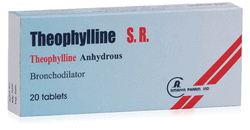Emergency Strategy - How to treat theophylline overdose

Emergency strategy- How to treat theophylline overdose.
Theophylline overdose is characterized by the collection of symptoms and signs which include agitation, irritability, tremors, tachycardia, tachypnea, restlessness, nausea and vomiting. Theophylline overdose may also present with hypokalemia, hypocalcemia, hyperglycemia, raised serum amylase, metabolic acidosis and ketosis. The cardiovascular effects such as ventricular fibrillation, idioventricular rhythm, atrial arrhythmias and multifocal ventricular ectopic are common findings. Acute case of overdose of theophylline may present with acidosis, hypercalcemia, hyperglycemia , hypokalemia and hypophosphatemia.
Theophylline will cause the release of catecholamines. Besides that, theophylline will inhibit the degradation of cyclic AMP by phosphodiesterase. Toxicity is mostly occur due to low dose of chronic theophylline intake . Theophylline consists of 80% of aminophylline.
The investigation required are full blood count, urea and electrolytes, creatinine, arterial blood gases, ECG, phosphate, liver function test and glucose. Serial of serum level measurements are required to determine the peak concentration of theophylline. The serum level measurement should be repeated after acute overdose cases due to delay in absorption from sustained release preparation.
The emergency approaches involved consideration of gastric lavage ( within 1-2 hours after ingestion.) and activated charcoal in multiple doses. Whole bowel irrigation ( polyethylene glycol) is considered for sustained released preparation overdose. These techniques will eliminate theophylline from the gut. Standard anti arrhythmic and propanol are considered for ventricular tacchyarrhythmias. Esmolol and propanol are considered for extreme tachycardia. Vasopressor and volume expansion are considered for hypotension.
Hemoperfusion, peritoneal dialysis and hemodialysis are considered in case of chronic ingestion of theophylline with serum theophylline level > 40- 60 mg/l ( 200- 300 micromol/l), acute ingestion with serum theophylline level>180 mg/l ( >440 micromol/l) or in patient with serum theophylline level > 180 mg/l ( >440 micromol/l) or in patient with severe toxicity and complication such as life threatening cardiovascular complication or intractable seizures. Convulsion is treated with barbiturates and benzodiazepines as phenytoin is not working). H2 receptor antagonist and proton pump inhibitor are given as theophylline may induce upper GI hemorrhage/ peptic ulcer. Drugs such as cimetidine should be avoided as it inhibit metabolism of theophylline and promote accumulation of theophylline. Potassium supplement is given to the patient ( mostly in acute phase) and always remember to monitor the potassium level regularly.
Theophylline overdose is characterized by the collection of symptoms and signs which include agitation, irritability, tremors, tachycardia, tachypnea, restlessness, nausea and vomiting. Theophylline overdose may also present with hypokalemia, hypocalcemia, hyperglycemia, raised serum amylase, metabolic acidosis and ketosis. The cardiovascular effects such as ventricular fibrillation, idioventricular rhythm, atrial arrhythmias and multifocal ventricular ectopic are common findings. Acute case of overdose of theophylline may present with acidosis, hypercalcemia, hyperglycemia , hypokalemia and hypophosphatemia.
Theophylline will cause the release of catecholamines. Besides that, theophylline will inhibit the degradation of cyclic AMP by phosphodiesterase. Toxicity is mostly occur due to low dose of chronic theophylline intake . Theophylline consists of 80% of aminophylline.
The investigation required are full blood count, urea and electrolytes, creatinine, arterial blood gases, ECG, phosphate, liver function test and glucose. Serial of serum level measurements are required to determine the peak concentration of theophylline. The serum level measurement should be repeated after acute overdose cases due to delay in absorption from sustained release preparation.
The emergency approaches involved consideration of gastric lavage ( within 1-2 hours after ingestion.) and activated charcoal in multiple doses. Whole bowel irrigation ( polyethylene glycol) is considered for sustained released preparation overdose. These techniques will eliminate theophylline from the gut. Standard anti arrhythmic and propanol are considered for ventricular tacchyarrhythmias. Esmolol and propanol are considered for extreme tachycardia. Vasopressor and volume expansion are considered for hypotension.
Hemoperfusion, peritoneal dialysis and hemodialysis are considered in case of chronic ingestion of theophylline with serum theophylline level > 40- 60 mg/l ( 200- 300 micromol/l), acute ingestion with serum theophylline level>180 mg/l ( >440 micromol/l) or in patient with serum theophylline level > 180 mg/l ( >440 micromol/l) or in patient with severe toxicity and complication such as life threatening cardiovascular complication or intractable seizures. Convulsion is treated with barbiturates and benzodiazepines as phenytoin is not working). H2 receptor antagonist and proton pump inhibitor are given as theophylline may induce upper GI hemorrhage/ peptic ulcer. Drugs such as cimetidine should be avoided as it inhibit metabolism of theophylline and promote accumulation of theophylline. Potassium supplement is given to the patient ( mostly in acute phase) and always remember to monitor the potassium level regularly.
